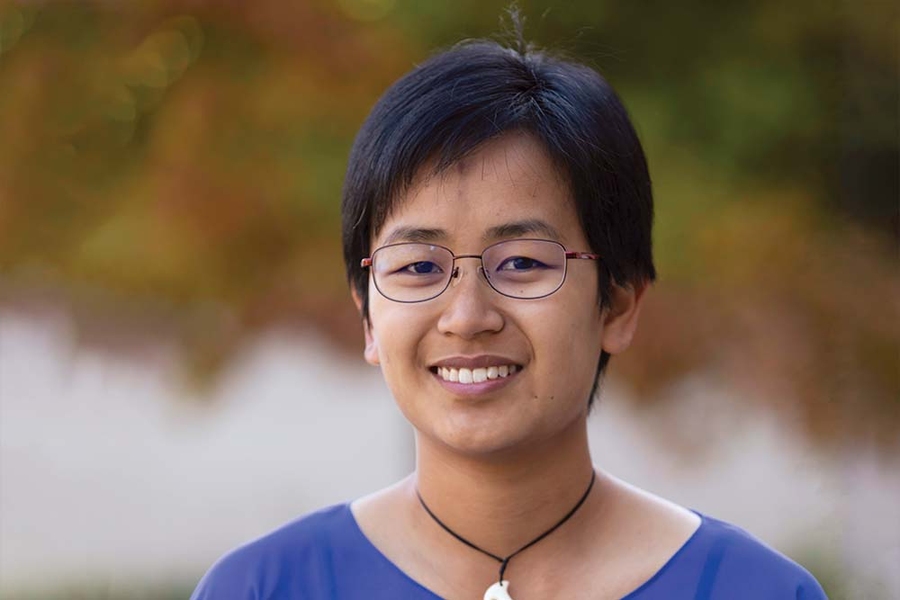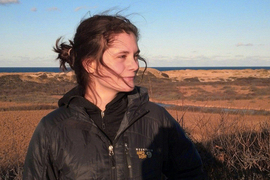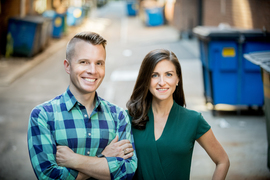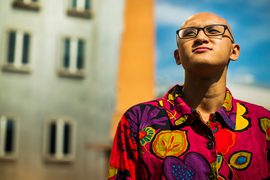Latifah Hamzah ’12 graduated from MIT with a BS in mechanical engineering and minors in energy studies and music. During their time at MIT, Latifah participated in various student organizations, including the MIT Symphony Orchestra, Alpha Phi Omega, and the MIT Design/Build/Fly team. They also participated in the MIT Energy Initiative’s Undergraduate Research Opportunities Program (UROP) in the lab of former professor of mechanical engineering Alexander Mitsos, examining solar-powered thermal and electrical co-generation systems.
After graduating from MIT, Latifah worked as a subsea engineer at Shell Global Solutions and co-founded Engineers Without Borders – Malaysia, a nonprofit organization dedicated to finding sustainable and empowering solutions that impact disadvantaged populations in Malaysia. More recently, Latifah received a master of science in mechanical engineering from Stanford University, where they are currently pursuing a PhD in environmental engineering with a focus on water and sanitation in developing contexts.
Q: What inspired you to pursue energy studies as an undergraduate student at MIT?
A: I grew up in Malaysia, where I was at once aware of both the extent to which the oil and gas industry is a cornerstone of the economy and the need to transition to a lower-carbon future. The energy studies minor was therefore enticing because it gave me a broader view of the energy space, including technical, policy, economic, and other viewpoints. This was my first exposure to how things worked in the real world — in that many different fields and perspectives had to be considered cohesively in order to have a successful, positive, and sustained impact. Although the minor was predominantly grounded in classroom learning, what I learned drove me to want to discover for myself how the forces of technology, society, and policy interacted in the field in my subsequent endeavors.
In addition to the breadth that the minor added to my education, it also provided a structure and focus for me to build on my technical fundamentals. This included taking graduate-level classes and participating in UROPs that had specific energy foci. These were my first forays into questions that, while still predominantly technical, were more open-ended and with as-yet-unknown answers that would be substantially shaped by the framing of the question. This shift in mindset required from typical undergraduate classes and problem sets took a bit of adjusting to, but ultimately gave me the confidence and belief that I could succeed in a more challenging environment.
Q: How did these experiences with energy help shape your path forward, particularly in regard to your work with Engineers Without Borders – Malaysia and now at Stanford?
A: When I returned home after graduation, I was keen to harness my engineering education and explore in practice what the energy studies minor curriculum had taught by theory and case studies: to consider context, nuance, and interdisciplinary and myriad perspectives to craft successful, sustainable solutions. Recognizing that there were many underserved communities in Malaysia, I co-founded Engineers Without Borders – Malaysia with some friends with the aim of working with these communities to bring simple and sustainable engineering solutions. Many of these projects did have an energy focus. For example, we designed, sized, and installed micro-hydro or solar-power systems for various indigenous communities, allowing them to continue living on their ancestral lands while reducing energy poverty. Many other projects incorporated other aspects of engineering, such as hydrotherapy pools for folks with special needs, and water and sanitation systems for stateless maritime communities.
Through my work with Engineers Without Borders – Malaysia, I found a passion for the broader aspects of sustainability, development, and equity. By spending time with communities in the field and sharing in their experiences, I recognized gaps in my skill set that I could work on to be more effective in advocating for social and environmental justice. In particular, I wanted to better understand communities and their perspectives while being mindful of my positionality. In addition, I wanted to address the more systemic aspects of the problems they faced, which I felt in many cases would only be possible through a combination of research, evidence, and policy. To this end, I embarked on a PhD in environmental engineering with a minor in anthropology and pursued a Community-Based Research Fellowship with Stanford’s Haas Center for Public Service. I have also participated in the Rising Environmental Leaders Program (RELP), which helps graduate students “hone their leadership and communications skills to maximize the impact of their research.” RELP afforded me the opportunity to interact with representatives from government, NGOs [nongovernmental organizations], think tanks, and industry, from which I gained a better understanding of the policy and adjacent ecosystems at both the federal and state levels.
Q: What are you currently studying, and how does it relate to your past work and educational experiences?
A: My dissertation investigates waste management and monitoring for improved planetary health in three distinct projects. Suboptimal waste management can lead to poor outcomes, including environmental contamination, overuse of resources, and lost economic and environmental opportunities in resource recovery. My first project showed that three combinations of factors resulted in ruminant feces contaminating the stored drinking water supplies of households in rural Kenya, and the results were published in the International Journal of Environmental Research and Public Health. Consequently, water and sanitation interventions must also consider animal waste for communities to have safe drinking water.
My second project seeks to establish a circular economy in the chocolate industry with indigenous Malaysian farmers and the Chocolate Concierge, a tree-to-bar social enterprise. Having designed and optimized apparatuses and processes to create biochar from cacao husk waste, we are now examining its impact on the growth of cacao saplings and their root systems. The hope is that biochar will increase the resilience of saplings for when they are transplanted from the nursery to the farm. As biochar can improve soil health and yield while reducing fertilizer inputs and sequestering carbon, farmers can accrue substantial economic and environmental benefits, especially if they produce, use, and sell it themselves.
My third project investigates the gap in sanitation coverage worldwide and potential ways of reducing it. Globally, 46 percent of the population lacks access to safely managed sanitation, while the majority of the 54 percent who do have access use on-site sanitation facilities such as septic tanks and latrines. Given that on-site, decentralized systems typically have a lower space and resource footprint, are cheaper to build and maintain, and can be designed to suit various contexts, they could represent the best chance of reaching the sanitation Sustainable Development Goal. To this end, I am part of a team of researchers at the Criddle Group at Stanford working to develop a household-scale system as part of the Gates Reinvent the Toilet Challenge, an initiative aimed at developing new sanitation and toilet technologies for developing contexts.
The thread connecting these projects is a commitment to investigating both the technical and socio-anthropological dimensions of an issue to develop sustainable, reliable, and environmentally sensitive solutions, especially in low- and middle-income countries (LMICs). I believe that an interdisciplinary approach can provide a better understanding of the problem space, which will hopefully lead to effective potential solutions that can have a greater community impact.
Q: What do you plan to do once you obtain your PhD?
A: I hope to continue working in the spheres of water and sanitation and/or sustainability post-PhD. It is a fascinating moment to be in this space as a person of color from an LMIC, especially as ideas such as community-based research and decolonizing fields and institutions are becoming more widespread and acknowledged. Even during my time at Stanford, I have noticed some shifts in the discourse, although we still have a long way to go to achieve substantive and lasting change. Folks like me are underrepresented in forums where the priorities, policies, and financing of aid and development are discussed at the international or global scale. I hope I’ll be able to use my qualifications, experience, and background to advocate for more just outcomes.
This article appears in the Autumn 2021 issue of Energy Futures, the magazine of the MIT Energy Initiative











